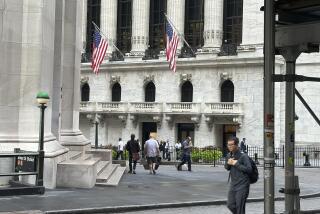Layoffs continue as Wall St. retools
- Share via
NEW YORK — Wall Street may seem like its old self again.
Financial giants including Goldman Sachs Group Inc. raked in mega profits in 2012. Bonuses are expected to fatten more Wall Streeters’ pockets than last year. The Dow Jones industrial average has been flirting with an all-time high after topping 14,000 for the first time in half a decade.
But droves of recent layoffs tell a different story. Indeed, analysts see a Wall Street that has shrunk in the four years since the financial crisis in part because of new regulations aimed at making the financial sector safer.
“We’re definitely seeing the shrinkage of the industry,” said Frederick Cannon, director of research at the investment bank Keefe, Bruyette & Woods in New York.
As Wall Street adjusts, thousands of highly paid employees are getting pink slips. As of Tuesday, financial firms globally had announced 114,708 layoffs over the last year, or 1.6% of their combined workforces, according to data provided by Bloomberg.
The Dutch financial giant ING Group said Wednesday that it would cut 2,400 positions in coming years, a day after British investment bank Barclays said it would slash 3,700 more jobs this year.
“There are basically no jobs,” said one equity trader in his 40s at a major financial firm in New York. “If you’re fired, it’s almost impossible to get rehired on Wall Street.”
Some of the trader’s colleagues have had their overall pay decline since before the crisis, he said. For some that has meant life adjustments: sending children to public schools instead of private ones, and vacationing at the Jersey shore instead of the Bahamas.
“People are definitely adjusting to the new reality,” said the trader, who was not authorized to speak publicly.
The city’s securities industry has yet to regain 20,200 jobs it lost since the financial crisis began, and is likely to continue losing jobs this year, according to the most recent figures released in October by New York Comptroller Thomas DiNapoli, whose office tracks Wall Street pay and employment. DiNapoli has said it appeared Wall Street was on track to give bigger bonuses than last year; his office plans to release a report this month.
Profits have been harder to eke out on Wall Street since the crisis. Making things tougher, analysts say, have seen regulatory requirements to increase capital, limiting how much big banks can lend.
New regulations — like those put in place by the Dodd-Frank financial overhaul of 2010 — have increased compliance costs and largely forced firms to get out of the highly profitable business of investing with their own funds. Low interest rates have also made increasing revenue difficult.
“The only way to generate profits now is to take a good look at expenses,” said Erik Oja, a banking analyst at S&P; Capital IQ.
Big banks have also been squeezing more profit from more traditional lines of business — writing mortgages, lending to businesses and helping companies raise money through the stock and bond markets.
Morgan Stanley swung to a profit in the fourth quarter in part through a surge from wealth management, where the bank has made a big push in recent years. The bank had 57,061 employees at the end of 2012, a 9% drop from two years ago.
Goldman Sachs reported a nearly threefold leap in fourth-quarter profit last year, on strong investment banking and trading. But Goldman boosted profit in large part by slashing its biggest expense: compensation.
Over the last two years, the bank has embarked on trimming expenses by $1.7 billion. Since 2010, Goldman’s workforce has dropped 9%, to 32,400 at the end of last year. A spokesman declined to comment.
Among major Wall Street powerhouses, JPMorgan Chase & Co. seems to be an outlier. Ranks at JPMorgan, which reported a record profit of $21.3 billion last year on surging mortgage and commercial lending and investment banking, have grown 8% over the last two years to 258,965 by year end.
But JPMorgan grew its ranks by expanding its consumer and commercial banking empire through the addition of hundreds of branches, a spokesman said. The bank opened its 1,000th branch in California last year.
Critics have said financial firms got too bloated before the crisis, sucking up a disproportionate share of U.S. corporate profits but not giving enough back to the overall economy. Instead of helping companies raise money to expand, critics said, Wall Street firms focused too heavily on creating and trading obscure financial products.
“There was a lot of money being made just moving money around, as opposed to actually providing financing for tractors and houses and everything else,” Cannon said.
The banking industry has not yet returned to the level of profitability it had before the crisis, Cannon said. But the trade-off may be that the financial system is safer.
“It’s probably better, but not nearly as much fun,” he said.
More to Read
Inside the business of entertainment
The Wide Shot brings you news, analysis and insights on everything from streaming wars to production — and what it all means for the future.
You may occasionally receive promotional content from the Los Angeles Times.










